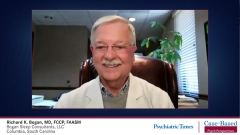
Case #1: 18-Year-Old Female With Type 1 Narcolepsy
Sleep experts present a case of an 18-year-old female preparing for college with EDS and cataplexy, and share their approach to treatment.
Episodes in this series

Richard K. Bogan, MD, FCCP, FAASM: I’m going to throw a couple of cases at you real quick, and I’m not going to go into great detail, but the one that comes to mind is an 18-year-old female. She’s getting ready to go to college. She’s worried about whether she can go to college because she has profound daytime sleepiness. Her Epworth Sleepiness Scale score is around 18. She’s fallen asleep in class in high school. She’s very smart, but her performance has been worse because she can’t stay awake for the exams and classes. Then she has these spells where her brother likes to surprise her, her brother sneaks up and surprises her, and she collapses, and completely loses muscle tone. It lasts only a minute or so, and she doesn’t fall, she just melts into the floor. She can still hear him laughing, she hasn’t fainted, she has just lost muscle tone. The family obviously was alarmed. She developed all these personality changes, was irritable and depressed, and all of this, worrying about whether she can go to college or not. She was seen by a cardiologist for arrhythmia, and eventually seen by a neurologist for a seizure disorder, and by a psychiatrist as well. But she described these vivid dreams, colorful dreams, and she had episodes of panic attacks at night when she would wake up and would panic and feel as if she couldn’t breathe. She was treated for attention deficit disorder as well with methylphenidate, but she was normal otherwise. Have you seen a case like this before?
Asim Roy, MD: Quite a few.
Richard K. Bogan, MD, FCCP, FAASM: Can you explain what was going on?
Asim Roy, MD: This sounds pretty classic for type 1 narcolepsy. Obviously, the excessive daytime sleepiness [EDS] is not unique to only narcolepsy. But you combine that with this startle response with atonia, and still being aware of her environment when she collapses or melts into the ground, is kind of that classic cataplexy description, where it’s ruled out syncope, ruled out most likely generalized seizure at least. It could still be partial seizures, but again, the probability of having that long of a duration and still being aware of your environment and bilateral, it’s most likely cataplexy. All the REM vivid phenomena, vivid dreaming, this is classic type 1 narcolepsy.
Richard K. Bogan, MD, FCCP, FAASM: The thing is that this poor girl didn’t realize she was sleepy. She knew she was falling asleep in class, but quantitatively, she didn’t know. I think it’s good to point out that the peak incidence of narcolepsy is right around age 15 or 16. Part of that as you pointed out is related to the autoimmune system. The autoimmune system is revved up at that age. If you get the flu or mononucleosis, and you kill the bug, and if you have HLA DQB1*0602 positivity, your HLA phenotype is right, and all the stars align, you might knock out those orexin neurons and develop type 1 narcolepsy.
There is a drug available to treat cataplexy in a teenager. Now she’s 18, so she’s technically an adult, but if she were 15, what do you think would be the drug of choice?
Asim Roy, MD: We would have to go with oxybate. It’s the only FDA-approved option for age 7 and above, for pediatric cases of narcolepsy. If she was under that age bracket, oxybate, whether it’s sodium oxybate, low-sodium oxybate, and potentially there’s this new, emerging once-a-night oxybate that’s going to be coming out soon. This would be the discussion I would have with her and her family.
Richard K. Bogan, MD, FCCP, FAASM: Sure. We always have to clinically correlate and see what the environment is. But I think it’s important for them to understand quantitatively how sleepy they are, but also understand what’s happening. I think they need to have a patient understanding of pathophysiology and the downstream effects of this orexin deficiency and why we choose the medicines we choose.
Transcript Edited for Clarity
Newsletter
Receive trusted psychiatric news, expert analysis, and clinical insights — subscribe today to support your practice and your patients.







